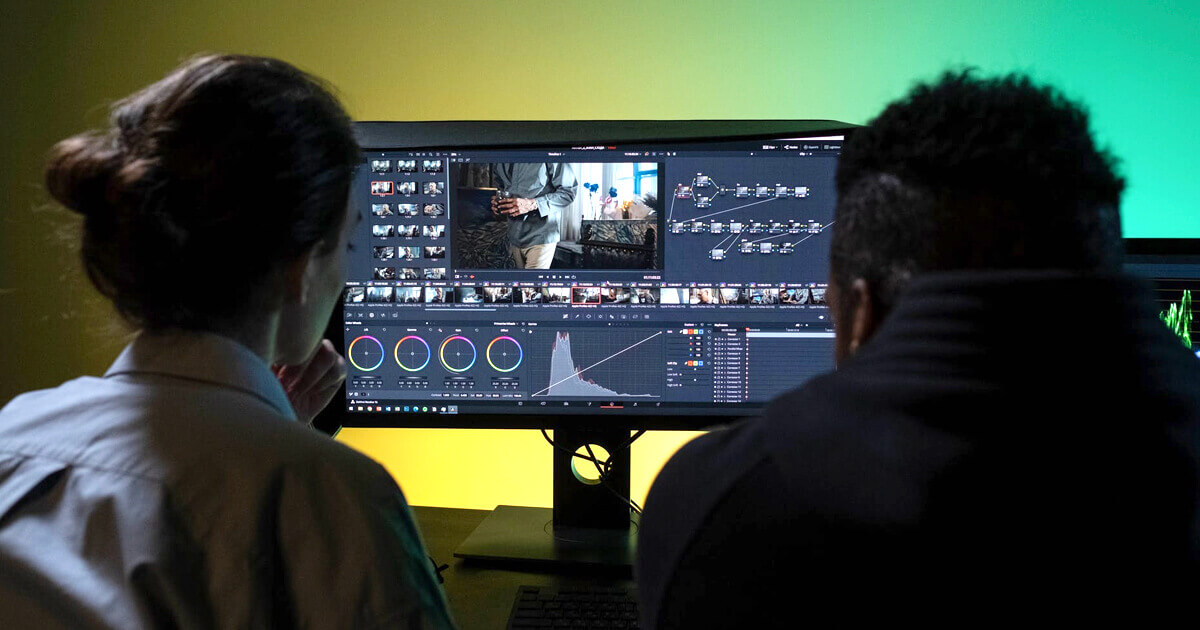On March 8th, 2022, Apple announced their new Mac Studio desktop computer. It’s a powerful little box; slightly taller than a Mac Mini with more processing power than Apple’s flagship Mac Pro. It’s also way cheaper than a Mac Pro.
How true to its figures the Mac Studio really is will be revealed once the machine launches on March 18. One thing that is evident right off the bat is how catered the Mac Studio is to video professionals.
For starters, the word studio is a dead giveaway (obviously). Moreover, Apple’s marketing positions the Mac Studio as a personal computer that can “transform any space into a studio”. However, it’s the Mac Studio’s focus on speed that makes it a sought-after tool for video pros.
Indeed, from speeding up ingest, to faster data transfer, to a focus on remote flexibility, Apple wants to speed up video workflows with the Mac Studio. And as any video pro can attest, time is money in the industry.
The faster teams can work and the more efficient they are, the better the end-result (and the more organizations can save on resourcing hours).
Ways the Mac Studio can speed up video-centric workflows:
Large File Transfer for Video Workflows
Use MASV to send terabytes of data with unparalleled speed.
1. Faster Downloads of Large Media Files
The Mac Studio comes with an internal 8 TB SSD. That’s a lot of space for the average user and a decent amount of storage for any video professional. Perhaps it’s even enough to break them from their external drive tether.
Video pros like a Digital Imaging Technician or an editor have to send large files to members of their team on a regular basis. Files like 4-8K RAW footage from a camera — which easily clocks in terabytes of data within a few minutes of recording. Unfortunately, most computers don’t have the space to receive these massive files.
This leads many to download their footage directly to an external drive — and herein lies the problem.

External drives cut your transfer speed
External drives and their connections are one of the most common causes of download speed bottlenecks and slowdowns. This is due to the read/write and transfer speeds of:
- The disk drive itself;
- The connection port on your computer; or
- Any dongles connected to those ports which end up splitting your port bandwidth.
Ideally, large files are downloaded directly to a local drive. It’s the fastest option as it requires far fewer I/O operations to move data than an external peripheral.
Mac Studio users can confidently download a large batch of media to their local disk instead of an external drive. This will drastically reduce the time from when a transfer is initiated to when the files are ready to use.
Massive Files Call for MASV
Send RAW files, hi-res proxies, DCPs, entire project folders, and more.

Photo by Manuel Chinchilla on Unsplash
2. Faster Ingest from Memory Cards
Similar to downloading large files faster, the Mac Studio allows users to ingest media faster with its built-in memory card slot.
Again, whenever an external dongle or drive is introduced to a machine, it automatically determines the transfer speed of data. One could have amazing CPU performance but if the memory card dongle can only transfer a few megabytes per second, so be it.
The Mac Studio doesn’t require a dongle attachment. It has a built-in memory card reader which is located on the front of the machine for easy access. Videographers (and photographers) can easily pop in their camera’s memory card and start ingesting files into their editing suite.

3. Better Data Transfer
The Mac Studio comes equipped with USB type-A and -C ports on the front of the box, as well as four Thunderbolt 4 (TB4) ports in the back. The USB-A ports are there for compatibility with devices that haven’t caught up with the times. On the other hand, USB-C is great news for those with large file transfer needs.
According to Apple, the Mac Studio with a single M1 chip will offer 10 Gbit/s data transfer speeds with the front two USB-C ports. If upgraded to the dual M1 Ultra chip, the USB-C ports are essentially TB4s with 40 Gbit/s of data transfer speeds per port.
Unfortunately, this still doesn’t solve Apple’s questionable decision to stick with a lightning cable for the iPhone 13.
We’ve spoken before about the data transfer problem awaiting iPhone 13 ProRes files. Lightning is not equipped to adequately transfer the large file sizes that come with a ProRes codec. USB-C would be the far superior option and as evidenced by the Mac Studio, it’s clearly Apple’s go-to for data transfer moving forward. At least with pro users.
4. Faster Rendering and Encoding
The bane of any video professional’s existence: slow graphics processing.
The Mac Studio has made some bold claims about it’s GPU processing power and Media Engine. A whopping 80 percent faster than the highest-end Mac Pro with a AMD Radeon Pro W6900X graphics card. Early benchmark reports show the Mac Studio neck-and-neck with Threadripper 3990X 64 core processor.
With this sort of horsepower, the Mac Studio (with M1 Ultra) claims to be able to render massive 3D environments and play back 18 streams of ProRes 422 video.
This is by far the most noteworthy part of the Mac Studio announcement. Time will tell how true to word the GPU performance is but the implications for video professionals can mean saving on hours of rendering and encoding time. This is a huge asset near the end of projects, where revisions are at their highest and time isn’t a luxury (is it ever?).

5. Wider Workspaces
As mentioned, the Mac Studio has four Thunderbolt display ports on the back of the box to connect four external monitors with 5K display quality. Creating a wider workspace means less switching between apps, pages, and panels. For example, editors and colorists can see a wider view of their project timelines. They can also keep their media bins, effects controls, and viewer panels open at the same time.
6. Emphasis on Remote Work
Going back to Apple’s positioning statement up top, the Mac Studio will “transform any space into a studio”.
It’s an important sentiment now that remote work is the norm and many employees are adamant on staying home. For video teams, having access to enterprise-level hardware is one of the biggest hurdles facing remote work. Mac Studio’s small footprint yet big processing power can make remote employees more efficient at home.
Additionally, the small footprint means the Mac Studio can easily be taken to remote location shoots. Most on-location shoots will have a display monitor available. The Mac Studio brings the power of a desktop computer on the road; a more capable machine to do on-set coloring, shot previews, logging, etc.
Stop Shipping Hard Drives
Send huge files over the cloud with MASV.

Photo by Ron Lach from Pexels
Speed Up Your Video Workflow
The Mac Studio looks to be a game-changer for video professionals who want to speed up their workflow.
- The machine is lightweight and compact, which makes it ideal for home office set-ups or on-location shoots.
- It’s equipped with fast transfer ports like Thunderbolt 4 and it has a built-in SD card reader to avoid the ingest bottlenecks.
- The addition of four Thunderbolt ports on the back of the machine allows for more external displays to be plugged in. This gives video editors, colorists, VFX artists and more the option to widen their workspace and see more of their timeline.
- Mac Studio’s 8 TB internal SSD affords plenty of room to download large files straight to the local disk — which is faster than downloading files to an external drive.
- And last but certainly not least, the Mac Studio’s sheer CPU and GPU performance will drastically speed up playback, rendering, and encoding of large files.
Media files are only getting larger which is why technology like the Mac Studio is so important to the productivity of video pros and their workflows. Moving heavy assets is no easy feat which is why video teams around the world use MASV to deliver large files, fast.
MASV is file sharing for video workflows with big data demands. The type of projects that require hundreds of gigabytes—even terabytes to be delivered on deadline, regardless of location. We are trusted by film, television, digital media, and event professionals to deliver large copyrighted files and high-resolution assets faster than the competition.
MASV offers enterprise-grade secure file transfer. All transfers are encrypted and validated by the Trusted Partner Network; the industry-leading content protection assessment led by the Motion Picture Association.
MASV users can send up to 15 TB with a single file across a private AWS pathway. If you sign up today, you get 20 GB worth of data credits to use towards your transfer. After that, it’s $0.25 per gigabyte downloaded or you can reach out to us and build a custom plan that suits your workflow.
MASV File Transfer
Get 20 GB to use with the fastest, large file transfer service available today, MASV.